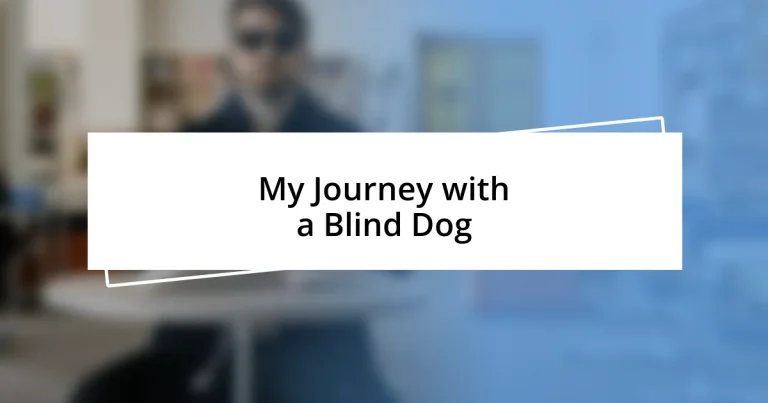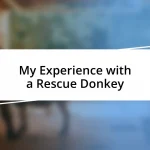Key takeaways:
- Blind dogs rely on their other senses, showing resilience and adaptability despite their vision loss.
- Training techniques such as verbal cues, sound associations, and tactile maps can significantly improve a blind dog’s confidence and navigation skills.
- Engaging activities like scent games and obstacle courses, along with maintaining a safe environment, enhance the bond and overall well-being of blind dogs.
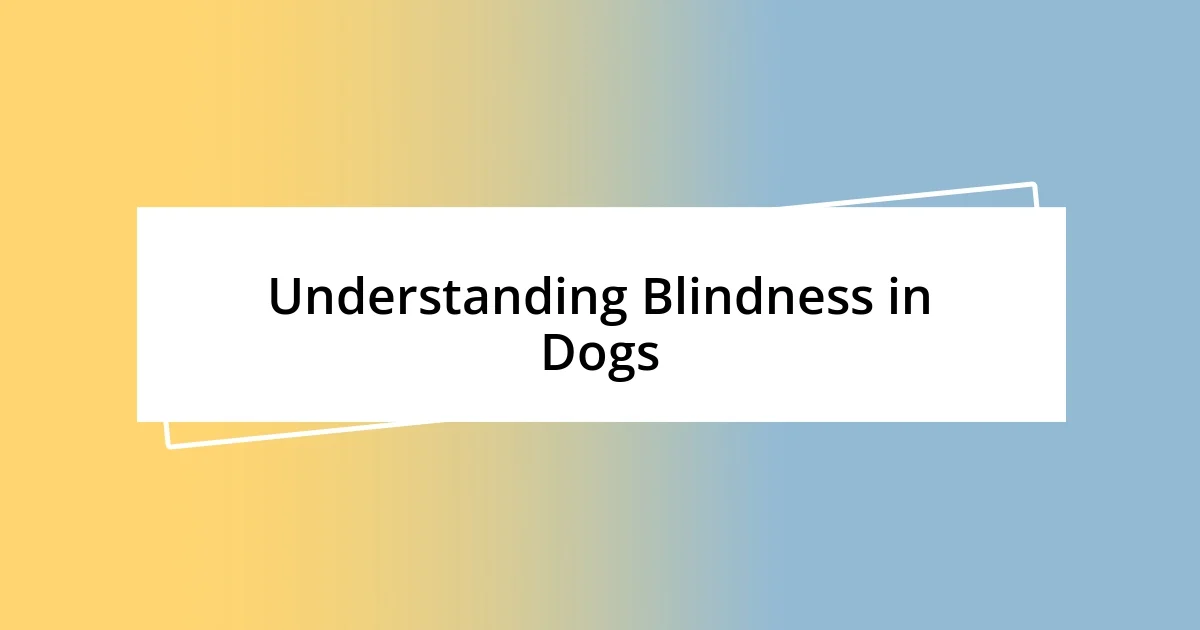
Understanding Blindness in Dogs
Blindness in dogs can stem from a variety of causes, including genetic factors, diseases, and injuries. I remember the moment I realized my dog was struggling to see; he would bump into furniture and seemed disoriented in familiar areas. It’s heartbreaking to witness, but understanding the underlying reasons can help you navigate this new reality.
When I learned that dogs rely heavily on their sense of smell and hearing, it gave me a sense of relief. It made me think: how often do we underestimate our pets’ capabilities? Despite my dog’s blindness, he adapted remarkably, using his other senses to explore the world around him.
It’s important to remember that just because a dog is blind doesn’t mean they can’t live a full, happy life. I’ve seen my dog find his way around by developing a unique confidence, almost as if he embraced the challenge. Have you ever watched a blind dog navigate a space with ease? It’s a testament to their resilience and adaptability, reminding us that love and patience can make a world of difference.
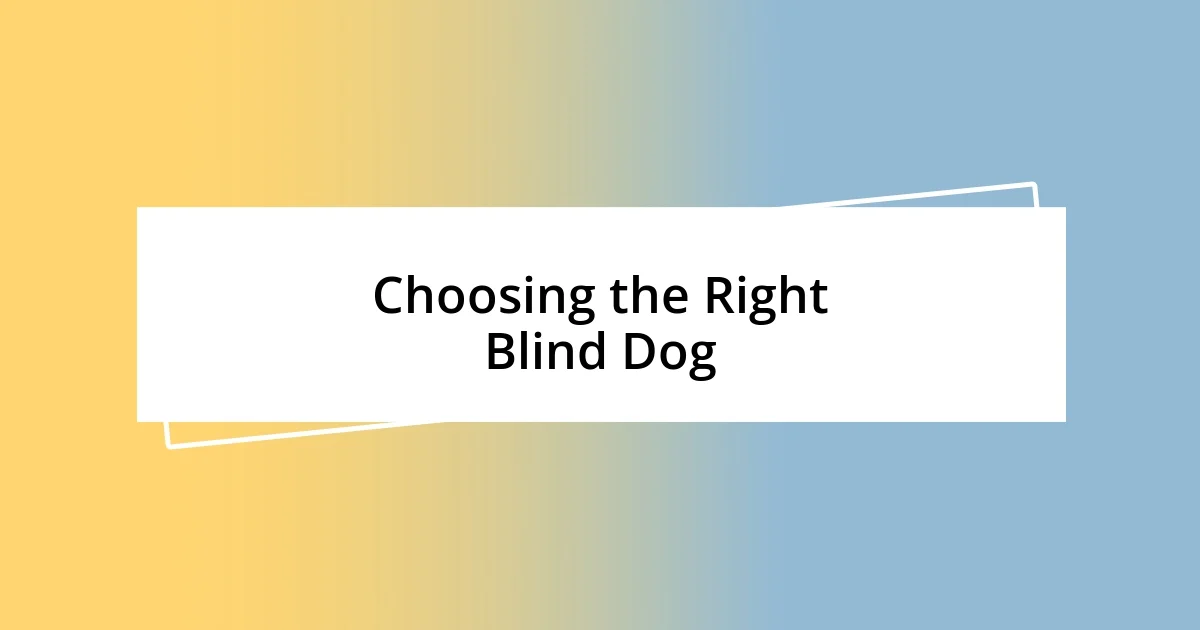
Choosing the Right Blind Dog
When considering a blind dog, it’s crucial to think about their personality. For example, some dogs are more cautious, while others are adventurous. I recall meeting a blind golden retriever named Max at a shelter; he was all about exploration, wagging his tail as he bumped into things playfully. I knew then that he would thrive in a loving home where he could be encouraged to build confidence.
Another aspect to consider is the dog’s age. Puppies might adapt more quickly to blindness, but they require more training and socialization. On the other hand, adult dogs may already have established habits. I adopted an older dog who lost his sight later in life, and it took time for him to adjust. Watching him learn to navigate our home was a journey of patience, but the bond we formed through that challenge was incredibly rewarding.
One significant factor is the dog’s breed and size. Some breeds are naturally more agile and better equipped to handle the adjustments that come with blindness. For instance, smaller breeds often navigate tight spaces with ease, while larger breeds might require more room to move. I’ve noticed that my dog, despite his blindness, has a knack for finding the comfiest spot in my house – a skill I attribute to his breed’s inherent curiosity.
| Factor | Considerations |
|---|---|
| Personality | Cautious vs. adventurous; adaptability to new environments |
| Age | Puppies may adapt quickly but need training; older dogs may require more patience |
| Breed and Size | Agility varies; smaller breeds often thrive in tight spaces |
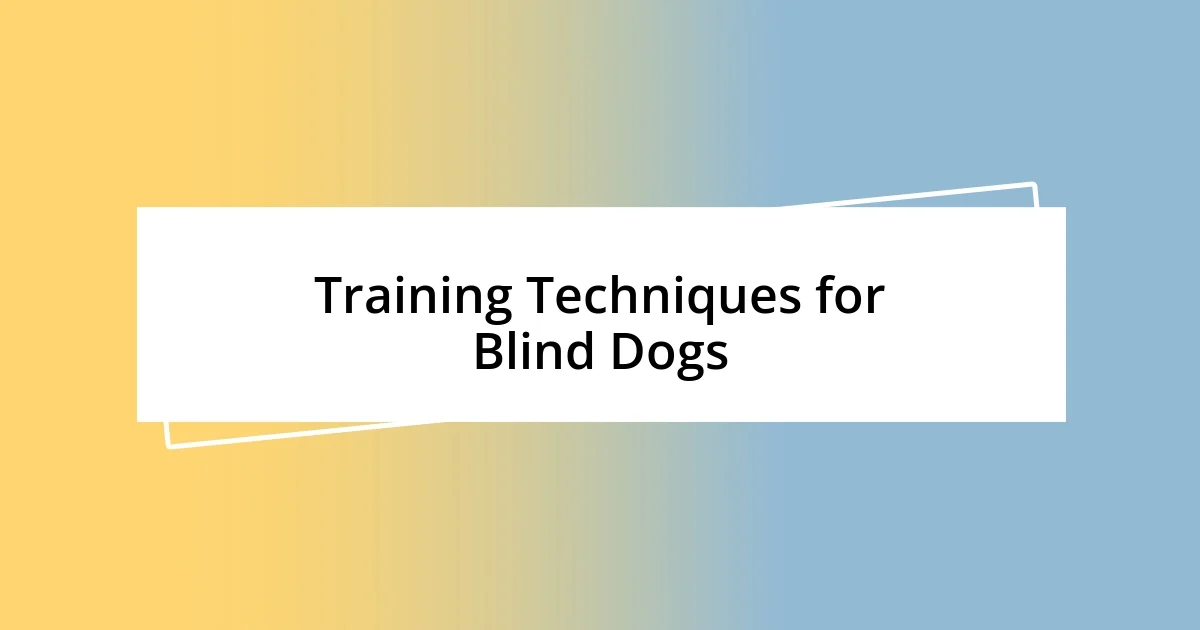
Training Techniques for Blind Dogs
Training a blind dog involves a blend of compassion, consistency, and creativity. I vividly remember the first time I introduced my dog to clicker training. The sound of the clicker was an instant cue for him, and with each successful command, I could see his confidence blossom. It’s fascinating how positive reinforcement can work wonders; I found that rewarding him with treats or praise was key to helping him learn new commands and tricks.
Here are some effective training techniques for blind dogs:
-
Use Verbal Cues: Loud and clear verbal commands help guide them. I often use specific, encouraging phrases that he associates with particular actions like “Come!” or “Sit!”
-
Leash Training with Sounds: Training him to recognize specific sounds associated with directions has been a game changer. For instance, I’ve attached small bells to his leash, which he quickly learned to associate with walking outside.
-
Obstacle Familiarization: I took the time to walk him through our home, letting him explore everything while guiding him verbally. Now, he confidently maneuvers around furniture he once struggled with.
-
Touch and Texture: I created a tactile map of our environment by using textured mats to help him discern different spaces. This adjustment made such a difference to his sense of security.
-
Routine is Key: Establishing a daily routine helped him anticipate activities and build trust in navigating his world. I recall how excited he would become when he heard our usual morning cue for breakfast.
Each of these techniques has been instrumental in building a strong bond between us, proving that patience and encouragement are essential ingredients in training blind dogs.
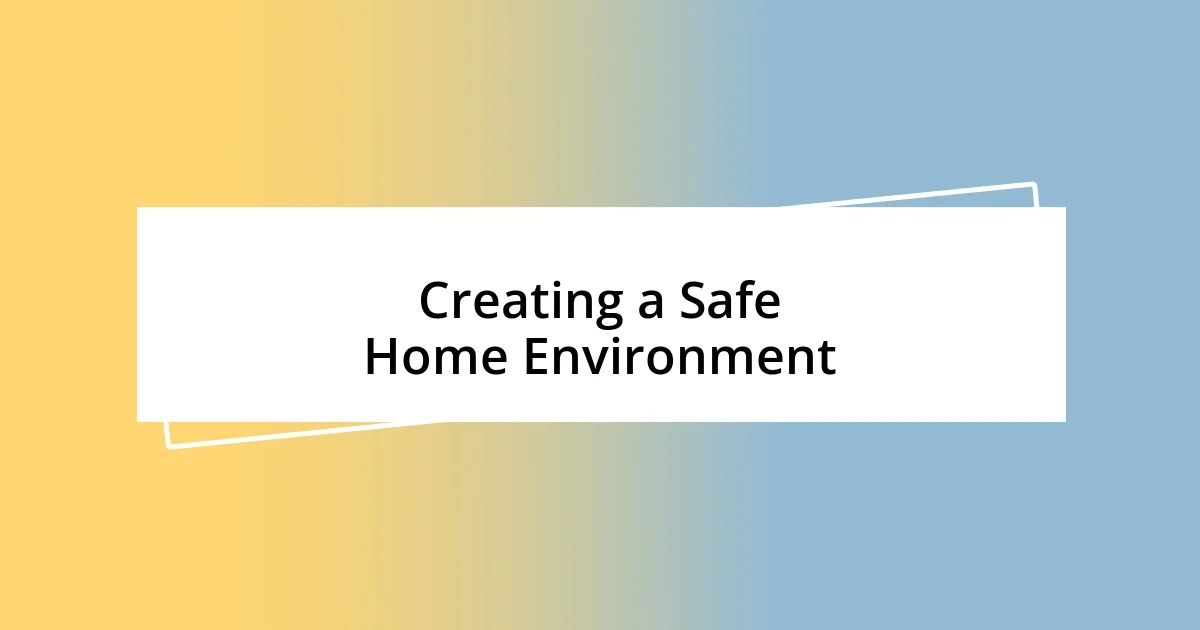
Creating a Safe Home Environment
Creating a safe home environment for a blind dog is vital for their well-being. I remember the first time I moved all the furniture around in my house. At first, I panicked, thinking it would be too overwhelming, but I quickly realized that consistently arranging their path made a massive difference. I used rugs and mats to create clear boundaries and familiar spaces that provided reassurance.
Removing hazards is just as important. I’ve found that baby gates can be a lifesaver, especially when it comes to stairs or areas I want to keep off-limits. Surprisingly, my dog quickly learned to navigate around these gates; it was as if he was testing his boundaries and gaining confidence in the process. Do you think about such simple barriers when considering safety? They can dramatically alter how a blind dog experiences their environment.
Additionally, keeping the home tidy contributes to a sense of security. Every time I would pick up stray shoes or toys, I noticed a marked improvement in my dog’s navigation abilities. It’s fascinating how clutter can be disorienting; I often felt like I was clearing not just the floor but also the worries in my dog’s mind. By maintaining a neat space, I could see my companion’s confidence soar, allowing him to explore freely and joyfully.
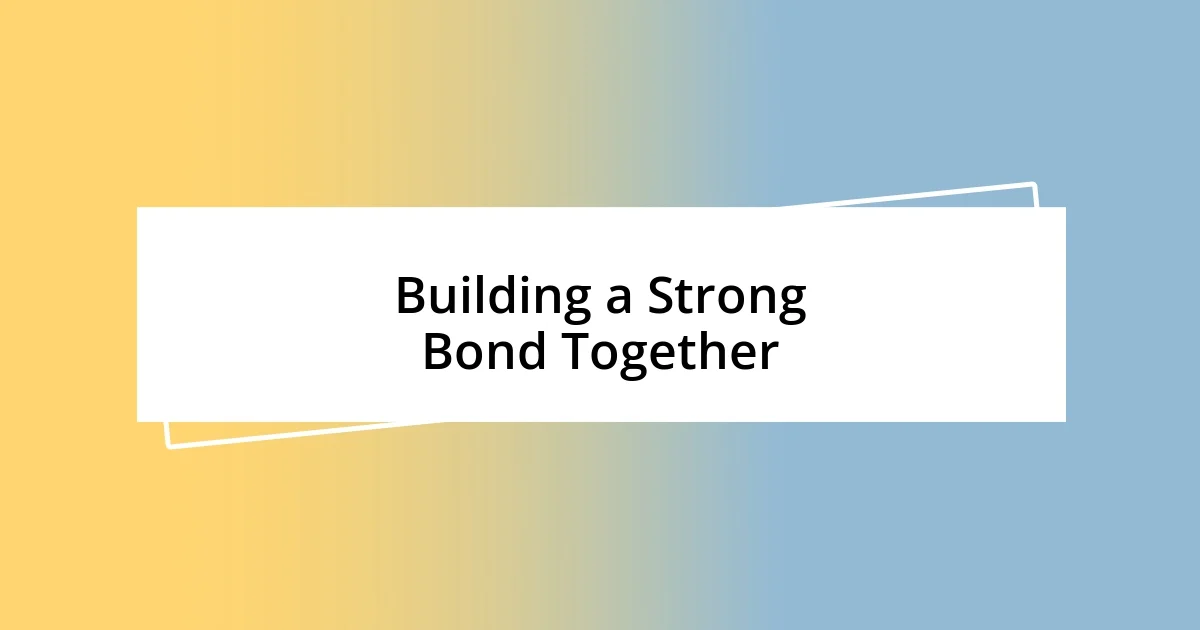
Building a Strong Bond Together
Building a strong bond with a blind dog has been one of the most rewarding experiences of my life. One day, as we were outside practicing our training, I felt an overwhelming sense of joy watching him respond to my voice. It struck me how vital that connection was—not just for his confidence but also for mine. Have you ever felt the thrill of seeing your dog’s eyes light up, even if they can’t see?
I think exploring new environments together played a significant role in strengthening our relationship. I remember visiting a local park for the first time, the air filled with excitement and new scents. As I guided him along the path, my heart raced each time he confidently followed my voice. It reminded me that every shared adventure—every new sound we discovered together—brought us closer, deepening our trust in each other. There’s just something about relying on one another that creates an unbreakable bond, don’t you agree?
On quiet evenings, we would sit together in the living room, unwinding in each other’s presence. During these moments, I would stroke his fur, sensing the comfort he found in my touch, but more importantly, it felt like our hearts synchronized. It’s incredible how simple actions, like sharing a serene space or offering gentle words of reassurance, can form a bridge of trust and love between a pet and their owner. This bond continues to grow, making each day richer and fuller than the last. How often do you take a moment to truly connect with your furry friend?
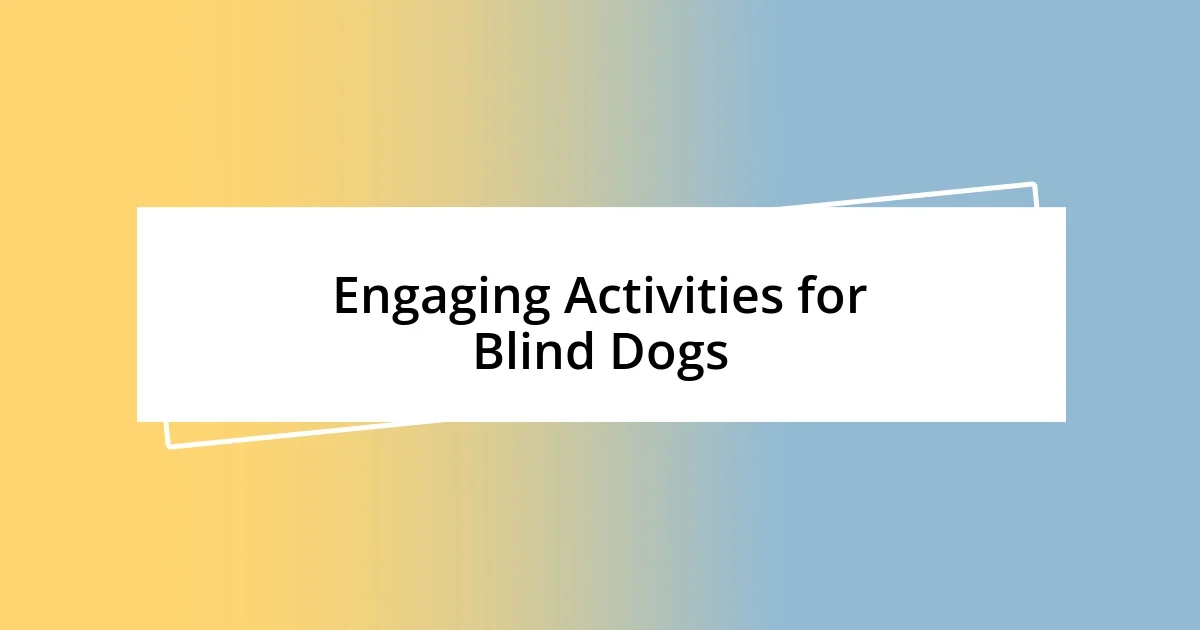
Engaging Activities for Blind Dogs
Engaging my blind dog in activities has been a delightful journey in creativity and connection. One of the simplest yet most effective activities I’ve enjoyed with him is using scent games. I remember hiding treats around the house—under cushions, within his favorite toys, and sometimes even inside a paper bag. Watching him use his nose to explore and “hunt” for these hidden treasures brought pure joy to both of us. Have you ever seen a dog’s excitement when they discover something delightful? It’s infectious!
Another engaging activity I’ve found is creating obstacle courses with varied textures. I’ve gathered items like soft blankets, sturdy cushions, and crinkle toys to build a mini adventure right in our living room. I encourage him to navigate through the course, guiding him with my voice or a gentle touch. Each journey through the course is different, and it’s heartwarming to witness his growing confidence as he tackles new challenges. Can you picture the thrill of watching your blind dog master a new skill, all while bonding over a game?
Lastly, I believe in the power of music for enriching the lives of our blind companions. I often put on calming music during our downtime, and I’ve noticed how it relaxes him. Occasionally, I play tunes with a lively beat for our playtime, leading to spurts of excitement where he bounces around, tail wagging. It’s amazing how something as simple as sound can uplift our spirits and create moments of joy and connection. Have you ever thought about how music might transform your dog’s day? It certainly sparks happiness in our home!












